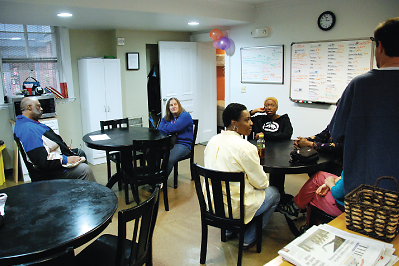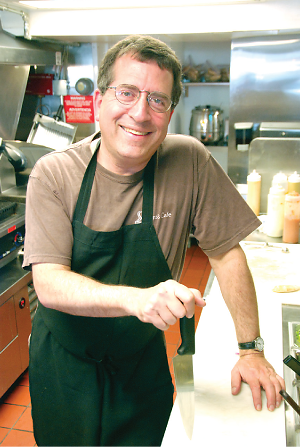Clubhouse Members Check Mental Illness at the Door
Abstract
The entrance to the B’more Clubhouse is a few steps down from street level in a stately red-brick townhouse just off Charles Street, Baltimore’s main north-south axis.
The clubhouse is part of the panoply of mental health services available in Baltimore—except that the clubhouse is not actually a mental health service. It is neither a residential facility nor a clinic. No psychiatrists work there. No psychotherapy happens. No medications get monitored. The only group session is lunch.
B’more Clubhouse is the first manifestation in Maryland of an international movement that began in 1948 with Fountain House in New York. Clubhouses serve as voluntary gathering places for people diagnosed with serious mental illnesses, a place of transition out of halfway houses, day programs, psychiatric hospitals, or solitary apartments into the ordinary world of work. B’more Clubhouse was formally established as an organization in October 2008 and opened for members in October 2009.
The organizing theme is the “work-ordered day.” Operating hours are 8:30 a.m. to 4:30 p.m., Monday through Friday.

Members and staff of the B’More Clubhouse in Baltimore gather twice a day to discuss their roles in the club’s operations. Once a month, they share the good news, too: completing a training program, celebrating a birthday, remaining substance-free for a year.
Members (and they are not “patients” or “consumers”) also interview new members and walk them through an orientation that includes a member-written handbook.
The Clubhouse members meet at 9:30 a.m. and 1 p.m. to discuss and sign up for the tasks that keep the place clean and functioning, from lunch prep to answering the phones, to sweeping up leaves on the sidewalk, to swabbing the bathrooms.
Besides those day-to-day tasks, members look out for one another. They phone others to check up on them if they have not shown up.
“We are about everything else in our members’ lives other than their illness,” Board of Directors President Tara Gallagher told Psychiatric News.
“So much of our members’ lives is consumed by their illness,” said Gallagher. “Many already spend many hours each day dealing with doctors’ appointments, therapy, or medication adjustment. Here, you check your illness at the door, and what you bring to the club is your talent, your skills, your aspirations, your life goals.”
Under Executive Director Veronica Lynn, M.S., membership has increased from about 30 early in 2011 to more than 100 now.
Curiously, the initial reaction from some mental health professionals was quite cool, said Lynn. “They feared we would take their clients away,” she said. But after hosting tours of the clubhouse for clinicians from Johns Hopkins, Sheppard Pratt, and the University of Maryland, the clubhouse began getting more referrals.
Meeting the Challenges of Ordinary Life
Everything shadows the working world. Simply just showing up can be a critical advance for many. The contact with other people, especially those dealing with similar struggles, can be stimulating.
Apparently simple tasks like meal planning and preparation and collecting the $1.50 from each member for lunch build skills for people who have never cooked for themselves and have been dependent on others for such ordinary aspects of life.
Members also write a monthly newsletter, relating events in their lives from their experience with mental illness to acquiring a cat. They also produce a weekly video “newscast” with tag-team anchorpeople and member-in-the-street interviews.
The commitment to preparing members for the working world extends beyond the clubhouse walls by means of a transitional employment program.
The B’more staff finds a local employer who offers an entry-level job to members. Then one of the three staff members goes to the job site and learns how to do the job. Only after that does the member arrive at the job, where he or she is trained by the staffer. The staffer serves another function—to step into the job if the member is unable to show up on a given day. That way, the employer is never left without help (see Restaurant Is About Lots More Than Great Pastrami).
Several members have been through the program, and Lynn is seeking additional employers to participate.
Members’ Backgrounds Vary Considerably
B’more also offers educational information and assistance to members. Thus far, seven members have gone back to school, two have completed bachelor’s degrees, and several have earned GEDs. Another has been accepted into the undergraduate social work program at the University of Maryland.
Members have a wide diversity of educational and employment histories. Some graduated from college, were married, or held significant jobs before the onset and diagnosis of their illness. Cathy was an elementary school teacher, Bev worked in marketing, David was an accountant, Brian worked for the Department of Defense, several served in the armed forces. Others have been able to hold only the simplest jobs because of the severity of their illness, yet they take part in the daily life of the clubhouse, as well.
Funding has largely come from about a dozen Baltimore foundations and more than 100 individual donors, said Gallagher.
“We chose not to seek public funding because it would mean following a medical model, including things like tracking medications,” said Gallagher. “That would be counterproductive to how a clubhouse works.”
Richard was one of the earliest B’More members. He spends much of his day at the clubhouse and helps write and edit the newsletter.
“Being a consumer to me means going to the hospital, smoking cigarettes,” said Richard. “I like not being considered a consumer here, being able to do something productive without having to be dependent on [other] people.” 
Information about the B’More Clubhouse is posted at www.bmoreclubhouseinc.org.
Clubhouse videos are posted on You Tube at www.youtube.com/bmoreclubhouse.
Restaurant Is About Lots More Than Great Pastrami
This is the story of a dream and a hope that intersect around lunchtime in the middle of Baltimore.

Attorney David Shapiro still practices law but heeded the call of a longtime dream by opening a little restaurant crammed into a narrow rowhouse on Preston Street and specializing in falafel, schwarma, corned beef, and pastrami.
Brian was diagnosed with a serious mental illness and hopes to work his way back to full-time employment step by step.
“I’m sort of a utility person,” said Brian, of his job at Shapiro’s Café.
Brian works there five days a week from 11 a.m. to 2 p.m. as part of the transitional employment program run by the B’More Clubhouse, a few blocks away.
“I wash dishes, take out the recycling, stock the shelves off the food delivery trucks, and make salads when we get busy,” he said.
Besides getting paid, the perks for the job include a free lunch. “The food is good, maybe too good,” he said. “I was gaining weight before I started cutting back.”
Brian will work there for six months, with the possibility to extend for another three months.
The transitional employment program is not a first permanent step into the workforce but is rather a resume builder. Members may work two or three such entry-level jobs for different employers before seeking full-time jobs. Brian would like to work next in the rare-book room at the Peabody Library, a job now held by another clubhouse member.
The process builds skills and, more importantly, a record of reliability when applying for future jobs.
Before Brian worked in his cafe, Shapiro hired two other B’More Clubhouse members. He expects to be a long-term supporter of the program.
“The staff bonds with the members, and we’re sorry to see them go at the end of their stint,” Shapiro said. “Brian rarely misses a day, and he’s always here 20 minutes ahead of time. It’s a place where I think he feels very welcomed and comfortable.”
“People are people,” said Brian. “They have whatever problems they have, but a lot of people want to get back into society, whether it’s working or volunteering.”



